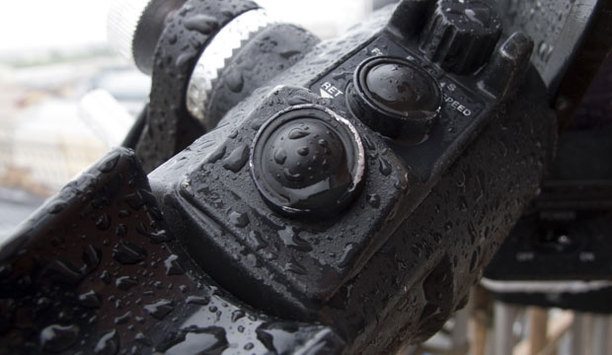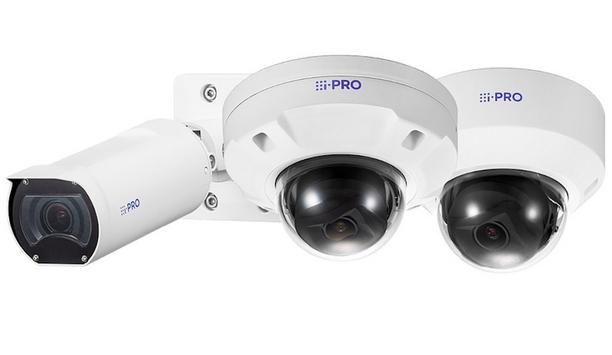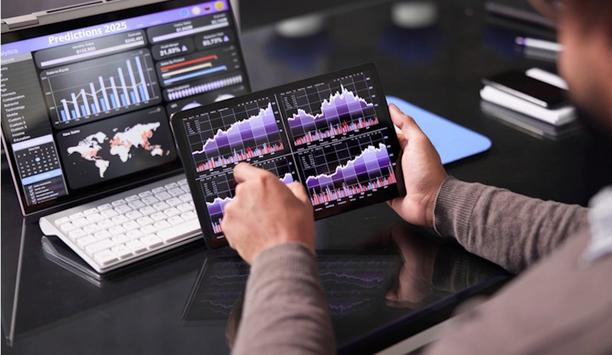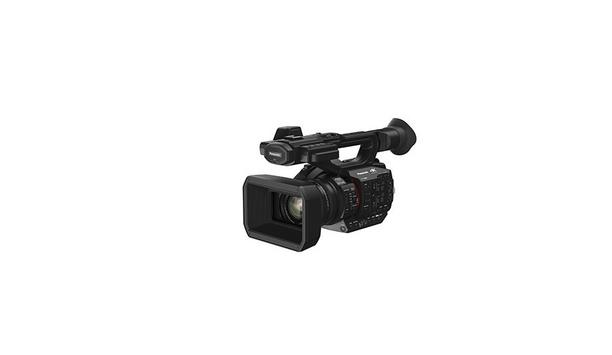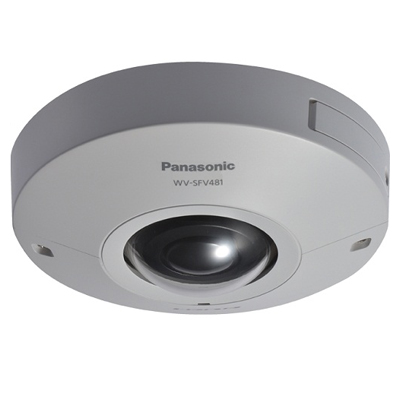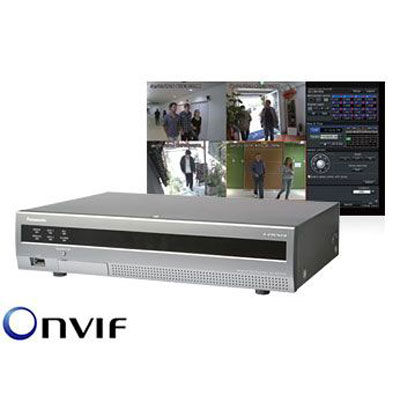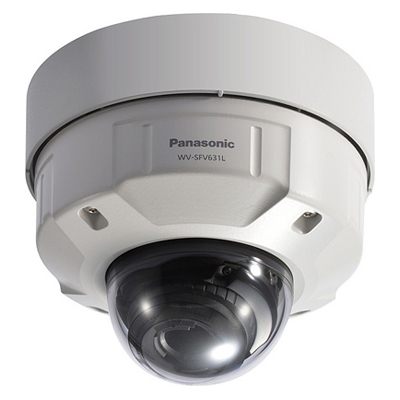Panasonic System Communications Company Europe - Experts & Thought Leaders
Latest Panasonic System Communications Company Europe news & announcements
i-PRO Co., Ltd. (formerly Panasonic Security), a pioneering manufacturer of edge computing cameras for security and public safety, announced the launch of the new U-series, marking the first time edge AI has been introduced to all its security camera lines. The U-series is designed for installations that need the accuracy advantages of AI-based object detection in security environments at an entry level. i-PRO U-series line-up The models are mainly suited for detecting intruders, loitering, direction, and line crossing The models are particularly suited for detecting intruders, loitering, direction, line crossing, and speeding. Providing an efficient, edge-computing approach without compromising on performance. "As a pioneer in edge computing within the security industry, i-PRO was the first to integrate AI across our entire S-series line, setting a new standard. Now, the i-PRO U-series line-up introduces essential edge computing technology to our entry-level models, transforming them into proactive devices that align with market trends,” said Gerard Figols, Chief Product Officer at i-PRO. New product line introduces imaging options Figols added: “By bringing the advantages of AI to fundamental security installations, we’re offering smarter technology for end-users who don’t require forensic search and advanced business insights based on metadata and attributes." The new product line introduces higher-resolution imaging options, including 2MP, 5MP, and 4K dome, box, and bullet cameras, enhancing clarity and precision. Additional features include: Advanced AI Image Analytics: AI-VMD for intelligent video motion detection Audio recording capabilities for enhanced situational awareness Increased Optical Zoom for improved focus on image clarity and analytics accuracy Direct-to-cloud VSaaS support Cameras deliver real-time insights while reducing bandwidth consumption The U-series camera line was designed to be a perfect companion for direct-to-cloud VSaaS deployments offering flexibility and scalability. As cloud-based solutions continue to evolve, future firmware updates will enable additional features and functionality. By combining Direct-to-Cloud connectivity with AI on the Edge, these cameras deliver real-time insights while reducing bandwidth consumption, improving response times, and enhancing data privacy. Strengthening cybersecurity In line with its mission to pioneer edge computing, i-PRO has integrated AI technology across the entire product line-up. Recognising the responsibility this entails, the company remains committed to enhancing its cybersecurity standard. While other companies adhere to FIPS 140-2, the new U-Series surpasses this with FIPS 140-3 level 3 compliance, utilising an NXP EdgeLock secure element, to provide the industry's highest level of data security. Requirements for cryptographic modules Level 3 certification includes stricter requirements for cryptographic modules Level 3 certification includes stricter requirements for cryptographic modules, further reinforcing security by improving physical tamper resistance and safeguarding against key extraction and hardware attacks. Featuring secure boot functionality, the cameras deliver strong protection against unauthorised access and cyber threats. Non-AI replacement models “i-PRO does not compromise cybersecurity by any means - not even in our entry-level camera line-up. By prioritising the highest level of cybersecurity, we demonstrate our commitment to data integrity, ensuring peace of mind for all our customers and users,” adds Figols. The new U-series consists of 28 models, with 15 featuring edge-processed AI analytics and 13 serving as non-AI replacement models. AI-enabled models will be available from June/July, and the non-AI models will be available later this year.
As the physical security industry looks toward 2025, i-PRO Co., Ltd. (formerly Panasonic Security) is highlighting four interlinked trends that are set to redefine how businesses, integrators, and security professionals approach security in the next year. These insights highlight the transformative role of edge computing, artificial intelligence (AI), the expansion of cloud computing, and how companies will integrate the wealth of available data. Shift toward proactive security The development and deployment of AI technology must balance innovation with responsibility Edge processing of AI-based analytics is rapidly transforming the security landscape by enabling systems to move beyond reactive responses to adopt proactive and preventative approaches. This shift allows organisations to address incidents before they escalate, improving both safety and operational efficiency. However, the development and deployment of AI technology must balance innovation with responsibility. Ethical use, privacy protections, and transparency will be essential as the data gathered becomes increasingly integrated into business systems and security solutions. Edge AI technology In 2025, edge AI’s role in the security industry will deepen, with advanced algorithms enabling real-time threat detection, on-site learning capabilities, and the beginning of context-aware insights that empower operators to act before incidents occur. “Moving away from the “one-size-fits-all” model, video cameras with AI on-site learning enable customised functionality that caters to the unique needs of every organisation,” said Hideo Noguchi, CTO, i-PRO. “By learning objects and characteristics on-site, distinct events can be tracked and analysed, further enhancing security and operational intelligence”. Challenge for 2025 The challenge for 2025 will not just be gathering more data but filtering and integrating it effectively Modern AI-enabled cameras and security systems can generate an overwhelming volume of data. The challenge for 2025 will not just be gathering more data but filtering and integrating it effectively. AI will play a critical role by summarising and contextualising information, helping operators focus on actionable insights. While AI can suggest courses of action based on data patterns, human decision-makers will remain central to interpreting and applying these insights. The role of data integration and decision-making “Data integration will also be pivotal. Security systems must go beyond isolated solutions to provide a seamless flow of information between devices and platforms,” said Gerard Figols, Chief Product Officer of i-PRO. “Visualisation tools will ensure that data is presented in an intuitive manner, empowering operators to make informed decisions quickly. It will be more important than ever to match these powerful edge computing devices with a compatible VMS to interpret the wealth of data available.” Cloud and edge computing: Striking the right balance While cloud computing will continue to offer flexibility and scalability, rising costs and latency challenges will provide a renewed focus on the role of edge computing. By processing data locally (within the camera), edge computing reduces reliance on cloud infrastructure and compute resources while enhancing response times and improving data accuracy by eliminating compression losses. New advancements Generative AI will better enable systems to anticipate and simulate potential threats New advancements in chipsets, like those from Ambarella, are poised to unlock generative AI capabilities at the edge, marking a significant step forward in customised and decentralised AI applications. Generative AI will better enable systems to anticipate and simulate potential threats. Functions and performance that were previously only possible in the cloud or on powerful servers, such as more complex scene recognition, text conversion, and search that uses direct text inputs to analytics running on the edge, will enable integrators to build lower-power systems that are more secure and cost-effective. The path forward: Ethical AI and open platforms As AI capabilities expand, the industry must prioritise ethical practices and robust cybersecurity measures. i-PRO is committed to ensuring that AI applications respect privacy and align with customers’ core values. Open platforms will remain a cornerstone of this approach, enabling integrators to build ecosystems that foster collaboration, customisation, and innovation while maintaining the highest standards of cybersecurity and data integrity.
Panasonic introduces two new 4K camcorders with integrated lenses and 1.0-type sensors, offering the advanced features and performance demanded by professionals alongside excellent weight balance and portability. The Panasonic HC-X2 and HC-X20’s high levels of video quality, expandability and adaptability allow them to be quickly and capably deployed in a wide variety of roles including news, interviews and events. The HC-X2/X20 offers superb optical performance via its integrated 24.5mm wide angle lens with 20x optical zoom and 5-axis HYBRID O.I.S.+, plus high-precision, high-speed AF with new face detection capabilities. Unlimited shooting length The camcorders support 4:2:2 10-bit 4K 30p/25p internal video recording, an extensive variety of recording formats including Super Slow Motion (100/120fps) and Variable Frame Rate (2fps to 60fps), and HEVC recording for more efficient storage. The camcorders support 4:2:2 10-bit 4K 30p/25p internal video recording Both models include professional video production features such as simultaneous display on the LCD monitor and Electronic Viewfinder, Triple Manual Rings for easy control, XLR audio input terminals, ND filter, dual SD card slots, unlimited shooting length and built-in Wi-Fi. The HC-X2, the higher-end model of the pair, additionally offers HLG2 (Hybrid Log Gamma) and V-log recording for creating 4K HDR content, as well as Ethernet connectivity and simultaneous SDI/HDMI output and HD live streaming capabilities via a range of streaming protocols. Medium-scale news gathering Panasonic will be proposing the HC-X2 as suitable for medium-scale news gathering and streaming, while the HC-X20 is ideal for small-scale independent interviews and events. The integrated lens offers outstanding versatility thanks to a 20x optical zoom which ranges from 24.5mm wide angle to 490mm telephoto. Additionally, i.ZOOM allows the HC-X2/X20 to reach 24x zoom at 4K and 32x zoom at FHD resolution. The high zoom range is achievable in a compact body thanks to a 4-Lens Drive System wherein each group of lenses is driven independently. Ensure subjects are always in sharp focus and accurately exposed with Face Detection AF/AE and a precise focus lens drive, which offers superior focussing speed, stability and tracking performance for both 4K and FHD recording. Additionally, the LCD monitor can be touched to activate subject tracking with colour recognition. Electronic image stabilisation The HC-X2/X20 feature a hybrid system in which optical and electronic image stabilisation work together The HC-X2/X20 feature a hybrid system in which optical and electronic image stabilisation work together to detect and correct camera shake across five axes, including rotational blurring. This enables smooth panning and beautifully steady handheld shooting even at 20x zoom or under unstable conditions like low- or high-angle shooting. By reducing friction on the drive section, the Ball O.I.S. System allows for delicate, precise and unobtrusive correction, even for tiny degrees of movement. Boasting a resolution of approximately 15.03 effective megapixels, the 1.0-Type MOS sensor offers UHD (3840 x 2160) recording with zero cropping, a moderate depth of field and an effective balance between image quality and sensitivity. Wider brightness range The camcorders support a wide range of bit rates and formats to suit professional and creative needs. For internal recording, UHD at 29.98p/25p and FHD up to 59.97p/50p in 4:2:2 10-bit quality is available, while UHD 60p 4:2:2 10-bit can be recorded externally via the HDMI output. Highly efficient HEVC recording (LongGOP/10-bit 4:2:0/MOV) is available at 59.97p/200Mbps, while the file format can be selected from MOV (QuickTime), MP4 and AVCHD. High Dynamic Range (HDR) video recording is available on the HC-X2 through its Hybrid Log Gamma (HLG) shooting mode. HDR video offers a wider brightness range than standard video, rendering images more natural and true-to-life. Uniform colour grading Users can shoot in 13-stop V-Log mode, providing the ideal base for accurate, uniform colour grading of footage Additionally, users can shoot in 13-stop V-Log mode, providing the ideal base for accurate, uniform colour grading of footage in post-production. By recording FHD images at high 100fps/120fps frame rates, then playing them back at standard 50fps/59.94fps frame rates, the camcorders can create a smooth slow-motion effect. Additionally, the HC-X2 offers a Variable Frame Rate (VFR) shooting function, allowing the user to set the frame rate to one of ten steps between 2fps and 50/60fps (with the selectable frame rate depending on the recording format) and produce creative, expressive videos with techniques such as overcranking and undercranking. Live streaming setup Built-in Wi-Fi makes connectivity easier than ever, while the HC-ROP mobile app enables users to operate the camcorders (including lens control and camera settings) wirelessly using tablets and smartphones. The HC-X2 is equipped with Ethernet, allowing for a highly stable live streaming setup, while the HC-X20 can be connected to a wired LAN through its optional USB Ethernet Adapter (sold separately). FHD live streaming uses popular RTSP/RTP/RTMP/RTMPS protocols, and allows for direct broadcast of concerts, sporting events, press conferences and more to platforms like Facebook and YouTube. Users can also record and stream simultaneously. Record and stream simultaneously The 3.5-inch, 2,760k-dot LCD monitor more than doubles the resolution and brightness of the previous model, providing excellent clarity and visibility even in bright sunlight. It offers electrostatic touch functions, allowing users to select menus with the tap of a finger. The camcorders also include a 2,360k-dot tiltable OLED viewfinder, which can be used simultaneously with the LCD monitor to improve work efficiency. To support fast, accurate manual focussing, the displays offer Focus Assist functions To support fast, accurate manual focussing, the displays offer Focus Assist functions including Expand, Peaking and Area Mode. The camcorders’ controls and features have been designed with the needs of video professionals in mind. The lens barrel features Triple Manual Rings for fast, simple and precise control of zoom, focus and iris operations, and there are 14 customisable User buttons available (nine on the body and five on the LCD touch panel). Long continuous shooting The integrated ND filter has four settings (Clear, 1/4, 1/16 and 1/64) and there are dedicated controls for Gain and AWB. The included battery has been designed to sit within the camera body shape rather than protrude and provides long continuous shooting times: approximately 3 hours and 50 minutes on the HC-X2 and 4 hours and 25 minutes on the HC-X20. The two SD card slots allow for long continuous shooting: recording media switches automatically and seamlessly from Slot 1 to Slot 2, and users can switch full cards with fresh cards while shooting is ongoing (known as Unlimited Relay Recording4). Records necessary scenes Other functions include Simultaneous Recording (identical data is record onto both cards), Background Recording (one card records continuously, the other records necessary scenes when the Rec button is turned on) and Dual Codec Recording5 (simultaneous recording in two different formats i.e. UHD and FHD). Two switchable XLR inputs support +48V Phantom Power Supply/MIC/LINE. Audio can also be recorded in 24-bit linear PCM (MOV), 16-bit AAC (MP4) or Dolby Audio (AVCHD). The HC-X2/X20 offers a number of broadcast-grade image adjustment functions, including Soft Skin (automatically adjusts and smoothens skin tones), 16-Axis Independent Colour Correction (allows colour matching for multiple cameras) and 8-Mode Gamma, which offers eight gamma presets, including two types of CINE-LIKE. In addition to the gamma modes, the HC-X2 is equipped with HLG and V-log, allowing the user to achieve the level of gradation their specific production requires.
Insights & Opinions from thought leaders at Panasonic System Communications Company Europe
Imagine a world where video cameras are not just watching and reporting for security, but have an even wider positive impact on our lives. Imagine that cameras control street and building lights, as people come and go, that traffic jams are predicted and vehicles are automatically rerouted, and more tills are opened, just before a queue starts to form. Cameras with AI capabilities Cameras in stores can show us how we might look in the latest outfit as we browse. That’s the vision from Panasonic about current and future uses for their cameras that provide artificial intelligence (AI) capabilities at the edge. Panasonic feels that these types of intelligent camera applications are also the basis for automation and introduction of Industry 4.0, in which processes are automated, monitored and controlled by AI-driven systems. 4K network security cameras The company’s i-PRO AI-capable camera line can install and run up to three AI-driven video analytic applications Panasonic’s 4K network security cameras have built-in AI capabilities suitable for this next generation of intelligent applications in business and society. The company’s i-PRO AI-capable camera line can install and run up to three AI-driven video analytic applications. The AI engine is directly embedded into the camera, thus reducing costs and Panasonic’s image quality ensures the accuracy of the analytics outcome. FacePRO facial recognition technology Panasonic began advancing AI technology on the server side with FacePRO, the in-house facial recognition application, which uses AI deep learning capabilities. Moving ahead, they transitioned their knowledge of AI from the server side to the edge, introducing i-PRO security cameras with built-in AI capabilities last summer, alongside their own in-house analytics. Moreover, in line with the Panasonic approach to focus more on collaboration with specialist AI software developers, a partnership with Italian software company, A.I. Tech followed in September, with a range of intelligent applications, partially based on deep learning. Additional collaborations are already in place with more than 10 other developers, across the European Union, working on more future applications. i-PRO AI-capable security cameras Open systems are an important part of Panasonic’s current approach. The company’s i-PRO AI-capable cameras are an open platform and designed for third-party application development, therefore, applications can be built or tailored to the needs of an individual customer. Panasonic use to be a company that developed everything in-house, including all the analytics and applications. “However, now we have turned around our strategy by making our i-PRO security cameras open to integrate applications and analytics from third-party companies,” says Gerard Figols, Head of Security Solutions at Panasonic Business Europe. Flexible and adapting to specific customer needs This new approach allows the company to be more flexible and adaptable to customers’ needs. “At the same time, we can be quicker and much more tailored to the market trend,” said Gerard Figols. He adds, “For example, in the retail space, enabling retailers to enhance the customer experience, in smart cities for traffic monitoring and smart parking, and by event organisers and transport hubs to monitor and ensure safety.” Edge-based analytics offer multiple benefits over server-based systems Edge-based analytics Edge-based analytics offer multiple benefits over server-based systems. On one hand, there are monetary benefits - a cost reduction results from the decreased amount of more powerful hardware required on the server side to process the data, on top of reduction in the infrastructure costs, as not all the full video stream needs to be sent for analysis, we can work solely with the metadata. On the other hand, there are also advantages of flexibility, as well as reliability. Each camera can have its own individual analytic setup and in case of any issue on the communication or server side, the camera can keep running the analysis at the edge, thereby making sure the CCTV system is still fully operational. Most importantly, systems can keep the same high level of accuracy. Explosion of AI camera applications We can compare the explosion of AI camera applications to the way we experienced it for smartphone applications" “We can compare the explosion of AI camera applications to the way we experienced it for smartphone applications,” said Gerard Figols, adding “However, it doesn’t mean the hardware is not important anymore, as I believe it’s more important than ever. Working with poor picture quality or if the hardware is not reliable, and works 24/7, software cannot run or deliver the outcome it has been designed for.” As hardware specialists, Figols believes that Panasonic seeks to focus on what they do best - Building long-lasting, open network cameras, which are capable of capturing the highest quality images that are required for the latest AI applications, while software developers can concentrate on bringing specialist applications to the market. Same as for smartphones, AI applications will proliferate based on market demand and succeed or fail, based on the value that they deliver. Facial recognition, privacy protection and cross line technologies Panasonic has been in the forefront in developing essential AI applications for CCTV, such as facial recognition, privacy protection and cross line. However, with the market developing so rapidly and the potential applications of AI-driven camera systems being so varied and widespread, Panasonic quickly realised that the future of their network cameras was going to be in open systems, which allow specialist developers and their customers to use their sector expertise to develop their own applications for specific vertical market applications, while using i-PRO hardware. Metadata for detection and recognition Regarding privacy, consider that the use of AI in cameras is about generating metadata for the detection and recognition of patterns, rather than identifying individual identities. “However, there are legitimate privacy concerns, but I firmly believe that attitudes will change quickly when people see the incredible benefits that this technology can deliver,” said Gerard Figols, adding “I hope that we will be able to redefine our view of cameras and AI, not just as insurance, but as life advancing and enhancing.” i-PRO AI Privacy Guard One of the AI applications that Panasonic developed was i-PRO AI Privacy Guard Seeking to understand and appreciate privacy concerns, one of the AI applications that Panasonic developed was i-PRO AI Privacy Guard that generates data without capturing individual identities, following European privacy regulations that are among the strictest in the world. Gerard Fogils said, “The combination of artificial intelligence and the latest generation open camera technology will change the world’s perceptions from Big Brother to Big Benefits. New applications will emerge as the existing generation of cameras is updated to the new open and intelligent next generation devices, and the existing role of the security camera will also continue.” Future scope of AI and cameras He adds, “Not just relying on the security cameras for evidence when things have gone wrong, end users will increasingly be able to use AI and the cameras with much higher accuracy to prevent false alarms and in a proactive way to prevent incidents." Gerard Figols concludes, “That could be monitoring and alerting when health and safety guidelines are being breached or spotting and flagging patterns of suspicious behaviour before incidents occur.”
There’s no denying that cyber-crime is one of the biggest threats facing any organisation with the devastating results they can cause painfully explicit. Highly publicised cases stretching from the US government to digital giant Facebook has made tackling cyber security a necessity for all major organisations. The consequences of breaches have just become more severe, with new GDPR rules meaning any security breach, and resultant data loss, could cost your organisation a fine of up to four per cent of global revenue or up to 20 million euros. Cyber-crime potentially affects every connected network device. In the biggest cyber-crime to date, hackers stole $1 billion from banks around the world, by gaining access to security systems. It’s more important than ever for organisations to be vigilant when it comes to their cyber security strategy. To help avoid becoming the next victim, I’ve put together a five-point cyber plan to protect your video surveillance system. 1. Elimination of default passwords A small change to a memorable, complex password could have huge consequences for your business It is estimated that over 73,000 security cameras are available to view online right now due to default passwords. ‘Password’ and ‘123456’ are among the top five most popular passwords with a staggering 9,000,000 login details matching this description. Guessable passwords create an unsecure security system which can result in an easy way for hackers to gain access to your organisation’s data, making you vulnerable to a breach. A small change to a memorable, complex password could have huge consequences for your business. Removing default passwords from products and software forces individuals to think of their own to keep their data safe. If a password system is not provided by your organisation we recommend that your password uses two or more types of characters (letters, numbers, symbols) and it is changed periodically. 2. Encrypted firmware Encrypting firmware is an important part of any organisations overall security system. Firmware can leave an open door, allowing hackers to access your data. All firmware should be encrypted to reduce the possibilities of it being downloaded from the manufacturers website and deconstructed. If the firmware posted is not encrypted, there is a risk of it being analysed by persons with malicious intent, vulnerabilities being detected, and attacks being made. With i-PRO cameras and recorders, all firmware is securely encrypted to mitigate analysis There have been cases where a device is attacked by firmware vulnerabilities even if there are no problems with the user's settings, rendering it inoperable, and DDoS attacks being made on other servers via the device. With i-PRO cameras and recorders, all firmware is securely encrypted to mitigate analysis. There is also a possibility of being attracted to spoofing sites by targeted attack email and firmware being updated with a version that includes a virus, so firmware must always be downloaded from the vendor's page. It may also be advantageous to combine this with an imbedded Linux operating system which removes all unused features of the device, it can help to reduce the chances of malicious entities searching for backdoor entities and inserting codes. 3. Removing vulnerabilities within the operating systems Vulnerability is the name given for a functional behaviour of a product or online service that violates an implicit or explicit security policy. Vulnerabilities can occur for a number of reasons for example, due to an omission in logic, coding errors or a process failure. Network attacks exploit vulnerabilities in software coding that maybe unknown to you and the equipment provider. The vulnerability can be exploited by hackers before the vendor becomes aware. You should seek to minimise these issues by looking for a secure operating system which is regularly updated. Panasonic has developed Secure Communications, a platform and package to protect against video tampering, altering, spoofing and snooping As a provider of security solutions, Panasonic is taking a number of steps to ensure its consumers remain safe and secure. We have developed Secure Communications, a platform and package to protect against video tampering, altering, spoofing and snooping. We have combined with a leading provider of highly reliable certificates and technology for detecting and analysing cyber-attacks with its own in-house embedded cryptography technology, to provide a highly secure and robust protection layer for its embedded surveillance products. 4. Avoiding remote login using Telnet or FTP Telnet and FTP are a very outdated source of software which as a result means they lack built-in security measures Telnet and FTP are a very outdated source of software which as a result means they lack built-in security measures. File transfer protocol or transfer through cloud-based services means the files and passwords are not encrypted and can therefore be easily intercepted by hackers. An encrypted software removes the risk of files being sent to the wrong person or forwarded on without your knowledge. Telnet predates FTP and as a result is even less secure. Hyper Transfer Protocol Secure is a protocol to make secure communications by HTTP, and it makes HTTP communications on secure connections provided by SSL/TLS protocols. The major benefits of using this system is that HTTPS and VPN encrypt the communications path, so data after communications is decrypted and recorded. If recorded data is leaked, it will be in a state where it can be viewed. With data encryption, however, it remains secure and can even be recoded to storage. Thus, even if the hard drive or SD card is stolen or data on the cloud is leaked, data cannot be viewed. 5. Use of digital certificates Private and public keys are generated at manufacture in the factory and certificates installed at the factoryDigital certificates are intended to safely store the public key and the owner information of the private key it is paired with. It provides assurance that the accredited data from a third party is true and that the data is not falsified. It is beneficial for all data to be encrypted with digital certificates. Digital certificates are far safer when issued by a third party rather than creating a self-signed version unless you are 100 percent sure of the receiver identity. From April 2016, some models of Panasonic series iPro cameras come with preinstalled certificates to reduce the risk of interception and the hassle of having to create one. With i-PRO cameras with Secure function, private and public keys are generated at manufacture in the factory and certificates installed at the factory. As there is no way to obtain the private key from the camera externally, there is no risk of the private key being leaked. Also, certificates are signed by a trusted third party, and the private key used for signing is managed strictly by the authority. In addition, encryption has been cleverly implemented to reduce the usual overhead on the IP stream from 20% to 2%.
Exhibitors at this year’s IFSEC are thinking outside the box in terms of how they communicate their value proposition and how they interface with customers. In the process, some are rethinking how big trade shows like IFSEC fit with their goals. Panasonic's approach to the 'race to the bottom' Thomas Lausten, MOBOTIX new CEO How Gallagher benefits from IFSEC without exhibiting Panasonic Systems Communications Europe Panasonic Systems Communications Europe is one of several companies emphasising solutions at IFSEC rather than products. In Panasonic's case, the approach helps to explain why the company doesn't have a traditional trade show stand. Instead, Panasonic opted to sponsor sessions in the security management education theatre on the show floor, and to host potential customers in a (quieter, cooler) meeting room upstairs. "We are inviting some of our key integrators for general business meetings in a relaxed environment, and offering two lunch-and-learn events about cybersecurity," says John Boyle, Panasonic's Country Manager for the UK and Ireland. There was standing-room only at the cybersecurity events, he adds. TBS specialises in 3D touchless biometrics and offers a full portfolio of fingerprint biometric technologies Compelling value proposition Trade shows seem historically to be about "here's our new box," Boyle observes. "We would rather talk to customers and channel partners about what issues they face, whether it's counting people or detecting scenes." Panasonic is creating solutions that combine their own technologies with third party partners filling in any gaps. "We are creating value propositions that we can take to integrators. They need a new story to tell their customers, not just a new box. Let's look at Panasonic's technology and how that adds value. If we have a compelling value proposition, we are giving our integrators an opportunity to get more business." Boyle acknowledges that the Panasonic approach is a way to bypass the price-focused "race to the bottom" that is lowering camera prices. "Pricing comes later if the value of a solution has already been established," he notes. Touchless Biometric Systems Philippe Niederhauser, Head of Sales and Marketing for Touchless Biometric Systems (TBS), Switzerland, is amazed at how many people come to IFSEC seemingly to browse around with little focus on what they need. "There are people who don't really know what they are looking for," he comments. "If I go to a trade show, I know exactly what I want." Niederhauser also sees some of his fellow exhibitors missing the boat in terms of marketing, tending to emphasise products rather than solutions. "Some people just put products out there, and they look similar; it is hard to differentiate," he says. "This is where you need to show a difference in products, and communicate the value proposition." TBS specialises in 3D touchless biometrics, and offers a full portfolio of fingerprint biometric technologies, also including 2D optical, 2D capacitative, and 2D multispectral systems. MOBOTIX keeps focus on technology A challenge in Thomas Lausten's new position is to communicate the advantages of MOBOTIX more effectively to the market Trends at this year's show are a big emphasis on cybersecurity, more integrated systems and applications that extend beyond the traditional definition of security, says Thomas Lausten, who just joined MOBOTIX as the new CEO. Cybersecurity is a strong suit of MOBOTIX, given the German video company's unique platform, an approach Lausten describes as "a computer with a lens." He says a challenge in his new position is to communicate the advantages of MOBOTIX more effectively to the market and to achieve the company's unrealised potential. "I don't see Mobotix as a traditional camera manufacturer," he says. "There is a fundamental difference between launching a camera and having a core philosophy as a company. I have been tasked with [managing] a company with a potential to be re-defined. Our mission is to develop a more open source company, although still an end-to-end solution, and a company that looks at the industry in a different way." He says the industry can expect new camera and software releases as MOBOTIX keeps its focus on technology. Quality communication through smaller events Gallagher, a New Zealand-based access control and perimeter security manufacturer, is an example of a company that seeks to benefit from IFSEC without exhibiting at the show. Steve Bell, Gallagher's Chief Technology Officer, travelled thousands of miles to the show for the networking opportunities, and Gallagher hosted a channel partner event in the evening, leveraging the fact that others have travelled to the show. "Trade shows are expensive outlays," says Bell. "For our strategy, we like more focused events, getting smaller groups together. Sometimes the big trade shows aren't focused enough. The people we might want to communicate with only have a short time, and it's a noisy environment. We don't have the quality communication we'd like to have. Smaller events provide more quality time." With manufacturers looking for new ways to engage with customers and build their businesses, the role of trade shows like IFSEC will, of necessity, continue to evolve.
One system, one card
DownloadEnhancing physical access control using a self-service model
DownloadAligning physical and cyber defence for total protection
DownloadUnderstanding AI-powered video analytics
DownloadHow to implement a physical security strategy with privacy in mind
DownloadPanasonic Ultra 360 Degree intelligent surveillance camera with 4k Engine (WV-SFV481)
Panasonic WJ-NV300 Network Disk Recorder
See Panasonic 6 series dome camera at IFSEC






















